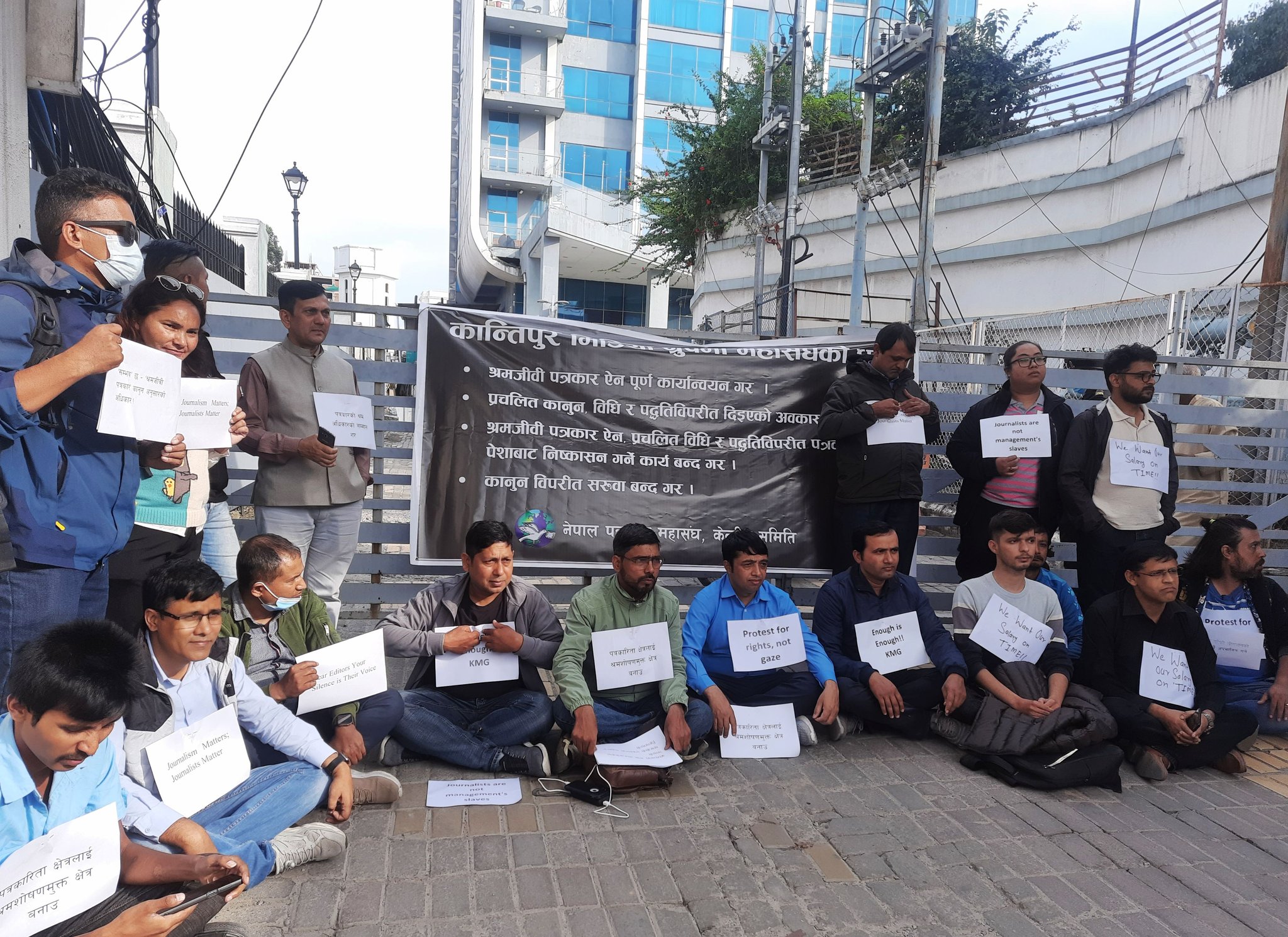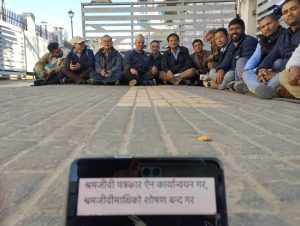“How many days make up one month at your office?”
“Mine is 60 days, 90 days at most.”
“Mine even more, 120 days.”
“It is 180 days in my office.”
“Mine is the longest, 240 days.”
When Nepali journalists meet on the sidelines of press conferences or during coffee breaks, this is how they often open the conversation: euphemistically asking about how long they have not been paid their monthly salaries. This is the basic income that they need to keep up with work, to survive, to feed their families, and to educate their children.
Those getting paid every 60 to 90 days are the lucky ones. Those reporting 120 days put on a grim face, but those having to forgo a salary for 180 days or more look hopeless and say they might quit journalism altogether.
Exceptions aside, talk to journalists working in the private media about their salaries and most of them will share the same story: We have not been paid for so many months, we are totally broke.
To be an employee of a publication or broadcasting company that pays decent salaries on time sounds like a status symbol. Thankfully, some professional and accountable media owners and publishers still sustain the glory and prestige of journalism in the midst of this gloom.
Show Me the Money
Journalists in Nepal are facing a crisis that impacts their creativity and careers: They are not paid wages on time, or not paid at all for months on end.
This has not become a topic of public discourse partly because neither side wants to talk about it. Journalists don’t want to project themselves as helpless professionals, and the media enterprises who fail to pay want to hide their incompetence.
Most critiques of the media landscape in Nepal are published by agencies supported by donors. These reports focus primarily on press freedom, media laws, and attacks on journalists – the stories the donors want to hear. As such, the withholding of journalists’ wages is rarely reported, despite also being a violation of the fundamental right to be paid for one’s work.
An unpaid journalist hesitates to report the problem. Taking a case to court is often considered a challenge by the media conglomerates, and the journalist runs the (perceived) risk of not being considered for a job by other media outlets. Besides, for better or for worse, there is a culture among the Nepali media community not to comment about the incompetence of others and expose their ills.
The wage-related grievances of Nepali journalists are not new. There were such issues in the past, too, but most often the problem would be quietly settled through closed-door negotiations between the media owners and the aggrieved journalists. Few journalists would report the cases to the authorities or speak about it in the open.
This time around, the wage issue has become even more flagrant. It is now an open shame.
Journalists working in big media houses are protesting for fair wages. The South Asia Press Freedom Report (2022-2023) mentioned that the Federation of Nepali Journalists (FNJ), an umbrella organization of journalists in Nepal, helped journalists to take up a legal battle against the fraudulent media owners.
The FNJ has received a total of 700 wage-related complaints from journalists in the last three years, said Ram Krishna Adhikari, a deputy coordinator of FNJ’s Press Freedom Monitoring and Working Journalist Welfare Committee.
“Most of such cases are resolved through the mediation of the FNJ, but the problem is journalists tend to suffer in silence rather than fight for their legitimate rights, fearing reprisal or that they might not be hired by another Nepali media,” said Adhikari.
“We receive more such cases now than in the past. Cases of media owners not paying their journalists are steadily increasing.”
Janmadev Jaisi, who heads the Working Journalists Association of Nepal, an initiative he founded to fight for the labor rights of Nepali journalists, has already led protest programs in front of 34 media houses. “In the last three years, we fought for the wage rights of over 3,400 working journalists and we were able to provide them justice,” he said.
The media owners have their own set of grievances. They say they cannot pay wages to journalists because of a breakdown in the revenue model. Media houses say revenue declined since the onset of the COVID-19 pandemic, as the advertisement market shrank along with the rise of social media platforms. Now corporate houses do not purchase ads through the papers and broadcast media because they can promote their products through social media pages.
Indeed, some of these reasons are just and valid. COVID-19 led to the shutdown of some papers, others reduced the number of pages. The ad market also saw a nosedive. But media owners often face allegations of funneling their profits earned during the heyday of business into real estate and housing, among other sectors, rather than re-investing it in their media houses.
“Most of the media owners used the income they made from media business into other sectors such as real estate and housing. They do have money, but they do not pay the workers,” Jaisi said.
He argued that the current financial crisis in the media is a framed narrative created to show that the big media houses are in trouble so that “the smaller outlets could cite the cases of the big houses and not pay their workers with abandon.”
Ironically, Nepal has strong laws to protect the rights of journalists. The Working Journalists Act (1993) requires managers – both publishers and owners – to hire journalists by providing appointment letters. Communication enterprises are required to pay minimum wages as determined by the government. A working journalist is entitled to monthly remuneration, enterprises are not allowed to withhold this pay, and after completing one year of service, each working journalist is entitled to a salary raise.
According to the law, communication enterprises not abiding by this act may face the following penalties: Grants or advertisements to be provided by the government of Nepal may be restricted or cut down, imports of communication materials or related raw materials may be restricted, and such enterprises may not be included in the press pool for government visits.
Media outlets who do not pay their employees have not had to face such penalties, however. That is because journalists do not report the cases in the first place, Jaisi said.
“At the same time, journalists also don’t go to the courts because the legal process is too long. Even if the courts issue verdicts in favor of the journalists, such verdicts are hard to be implemented in true letter and spirit,” he said. “Because of this, they don’t want to take up the legal battle.”

Journalists stage a sit-in in front of a media house demanding unpaid wages in October 2023. Photo from X/Bikash karki
Toll on Truth
As journalists can no longer depend on their media houses to earn a livelihood, some have resorted to taking up side jobs: teaching, interpreting, and providing consultancy services. Consequently, the quality of journalism suffers. In-depth and quality reporting becomes rare, and reporters tend to align themselves with political parties or other interest groups to ensure a steady income.
Under these circumstances, media could become a vehicle to spread misinformation, disinformation, and fake news, the tools political leaders and their cadres often use to malign and denigrate their opponents.
This is happening at a time when the Nepali media needs to be even more empowered to dig deep into various geopolitically contested issues involving India, China, and the United States – the three major powers competing to expand their influence in the strategically located nation. All three powers are invested in foisting their interests on Nepal and outdoing each other, and each of them wants to create a narrative in their favor. At the same time, Nepal’s political parties appear to align themselves with one or the other power, by design or by default, to curry favor to stay relevant and in power.
Truth may be a casualty to this great geopolitical game when the media is weak, or when journalists compromise their conviction for truth.
Writer and senior journalist Kanak Mani Dixit summarized the possible fallout in one of his recent articles (translated from Nepali):
Media has not been speaking up where it has to speak up. There is a selective bias in the media… The way media houses are treating the journalists has diminished their morale. So, in this situation, either the journalists give up or they may be compromised.
Innovate or Perish
Media professionals in Kathmandu agree that the old model of doing journalism will not work in this time of crisis, and that an alternative model has to be explored if we are to stay relevant in the profession. But no one is sure what that new model can be, should be, and will be.
Some see the subscription model as a workable alternative. Indeed, Setopati, a major online portal in Kathmandu, has executed that model. “This is the model we will have to follow ultimately. This is what is happening elsewhere too,” said Sudeep Shrestha, a journalist with Setopati. “We are doing well.”
But there is a catch: To make the readers pay for your content, you have to be able to create enriching content in the first place. To do that, you have to have a team of dedicated, competent professional journalists, for which you have to be able to pay them decent wages. And to do that, you have to have money.
Dedicated independent journalists in Nepal are facing this double-edged sword. They want to stay relevant in the profession, but they also need decent wages to survive. One positive spin in this saga of sadness is that new media outlets keep emerging even though the old ones shut down. No one knows how long this situation in Nepali journalism will last but as long as journalists do not give up, it will help avert the death of journalism – if not ensure decent, timely wages to journalists.

































